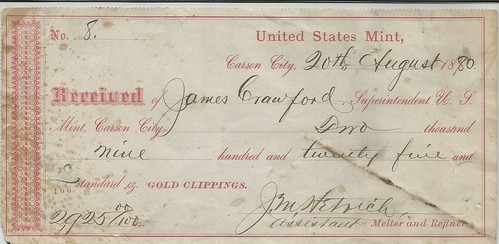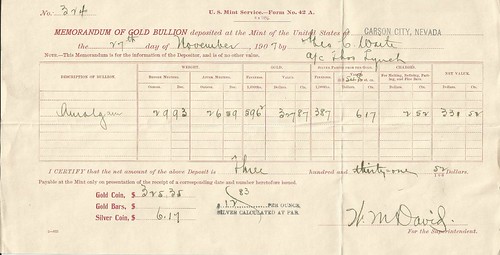
PREV ARTICLE
NEXT ARTICLE
FULL ISSUE
PREV FULL ISSUE
A CARSON CITY MINT GOLD CLIPPINGS RECEIPT
Dave Ginsburg submitted this article inspired by a Carson City Mint gold clippings receipt. Thanks! -Editor

I recently acquired this Carson City Mint receipt and, based upon information contained in From Mine to Mint by noted numismatic researcher Roger W. Burdette and subsequent consultation with the man himself, I believe that the receipt sheds some new light upon the Mint’s internal processes. To begin with, during the period from 1873 to 1933, gold was deposited with the Superintendent of the Mint and acknowledged with the receipt of the type shown below. 
The bullion was then delivered to the Melter & Refiner’s department to be turned into “standard” ingots of 90% gold and 10% alloy. The Melter & Refiner delivered the standard ingots to the Coiner’s department, which then rolled the ingots into coinage strip, cut the blanks and turned the blanks into coins, while the leftover strip was returned to the ingot melting room. While we know that the Mint’s processes were audited at least annually, that the various departments were only allowed specified “wastage” amounts and that the Mint officers were, through their performance bonds, personally liable for their department’s proper operation, this Gold Clippings Receipt suggests that the Mint’s bookkeeping processes were quite formal. This Receipt represents a fair amount of money: denominated in 2,925 standard ounces of gold valued at $18.60 each, it represents about $54,400.00. Because it is for “gold clippings”, I believe that it documents the delivery of coining strip leftovers (after coin blanks had been punched out) from the Coiner’s Department. If I am correct, then this Receipt is particularly interesting because it shows that inter-department transfers of precious metal were not made directly to one operating department from another, e.g., to the Melter & Refiner from the Coiner, but were instead made through the Superintendent’s office. One could infer that the Mint’s administrators sought to eliminate the possibility of “back-scratching” behavior by the operating departments or that they wished to tie the Superintendent to every step of the production process, even though the department officers were personally liable for financial losses in their departments. In any event, the presence of this Receipt implies that there was a matching receipt that documented the delivery of 2,925 standard ounces of gold clippings to the Superintendent from the Coiner. For those who are not that familiar with the Carson City Mint, 1880 was a busier gold minting year than the previous three. Carson City produced 51,017 half eagles and 11,190 eagles, which used about 18,300 ounces of standard gold. This Receipt was issued to Superintendent James Crawford, who was in office from late 1874 (appointed in September, formally nominated by President Grant and confirmed by the US Senate in December) until his death in March 1885 (following which coinage was suspended at the Carson City Mint until July 1, 1889). The Receipt was given by Josiah M. Hetrich, who is first listed as a “Cupeller” in the Carson City Mint in September 1875, next as “Humid Assayer” in September 1877, and “Melter & Refiner’s Assistant” in September 1879. He was nominated to be Assayer of the Carson City Mint by President Hayes and confirmed by the US Senate in December 1880. He presumably served as Assayer until the Carson City Mint was temporarily closed in November 1885. Mr. Hetrich was the brother of Frank D. Hetrich, who had a long career as an assayer, first in the assay department at the Denver Mint in 1865, then as Assayer (from December 1869 to mid-1873) and Superintendent (July 1873 to July 1874) of the Carson City Mint and finally as an employee in the Assay Department of the San Francisco Mint from November 1874 through at least mid-1893. Internal Mint receipts of this type seem to be uncommon. While I haven’t scoured auction archives, I can only point to two examples: Mr. Burdette illustrates an 1871 receipt from the Philadelphia Mint for silver coin on page 356 of From Mine to Mint and reports that these receipts were discarded after use; and, well-respected coin dealer Bill Shamhart illustrates an 1874 receipt from the Carson City Mint for silver bullion on his Numismatic Americana website. Can anyone point out other examples? To purchase Burdette’s From Mine to Mint, see: www.wizardcoinsupply.com/from-mine-to-mint.html To view the Carson City Mint receipt at Numismatic Americana’s website, see: www.numismaticamericana.com/americana-offerings/united-states-mint-at-carson-city-receipt-for-silver-bullion-1874/ Wayne Homren, Editor The Numismatic Bibliomania Society is a non-profit organization promoting numismatic literature. See our web site at coinbooks.org. To submit items for publication in The E-Sylum, write to the Editor at this address: whomren@gmail.com To subscribe go to: https://my.binhost.com/lists/listinfo/esylum All Rights Reserved. NBS Home Page Contact the NBS webmaster 
|